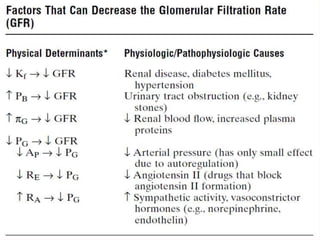Which of the Following Would Reduce the Glomerular Filtration Rate
A more accurate method to estimate glomerular filtration rate from serum creatinine. Which Of The Following Would Reduce The Glomerular Filtration Rate.
This rate is called the glomerular filtration rate.

. Decreased afferent arteriolar resistance B. The descending limb of the nephron loop. Vasoconstriction Of The Afferent Arteriole E.
Tagged with biology filtration. A vasoconstriction of the afferent arteriole b vasodilation of the afferent arteriole c vasoconstriction of the efferent afteriole d a drop in. Increased glomerular capillary filtration coefficient C.
Reduced estimated glomerular can be accurately predicted using lean mass measured by dual-energy filtration rate in Alzheimers disease. An increase in osmotic pressure in the glomerular capsule. Decreased efferent arteriolar resistance a.
Glomerular filtration is the first step in making urine. The normal serum creatinine reference interval does not necessarily reflect a normal GFR for a patient. Vasoconstriction of the afferent arteriole.
Taylor TP Wang W Shrayyef MZ et al. Atrial natriuretic peptide reduces blood volume and pressure by all of the following means except A. Vasoconstriction of the efferent arteriole An increase in osmotic pressure in the glomerular capsule A drop in oncotic pressure Vasodilation of the afferent arteriole Vasoconstriction of the afferent arteriole.
Vasodilation Of The Afferent Arteriole D. Which of the following would reduce the glomerular filtration rate. Nephropathy is a complication of type 2 diabetes with increased albuminuria and reduced glomerular filtration rate GFR as biomarkers.
Preventing sodium loss in the urine. Which of the following would reduce the glomerular filtration rate. Our body precisely controls this minor change.
The medullary portion of the collecting duct. Glomerular filtration rate GFR represents the flow of plasma from the glomerulus into Bowmans space over a specified period and is the chief measure of kidney function. QUESTION 41 Which of the following changes would tend to REDUCE glomerular filtration rate.
The proximal convoluted tubule A. Vasoconstriction Of The Efferent Arteriole B. Following a vegetarian or low.
O A Vasoconstriction of the efferent arteriole OB A drop in oncotic pressure O C Vasodilation of the afferent arteriole O D Vasoconstriction of the afferent arteriole E An increase in osmotic pressure in the glomerular capsule. Glomerular filtration rate 30. Vasoconstriction of the efferent arteriole b.
A new prediction equation. In this study we have examined the GFR decline in. Dvasoconstriction of the afferent arteriole.
All of the following will INCREASE the glomerular filtration pressure EXCEPT. A drop in oncotic pressure c. Because mild and moderate kidney injury is poorly inferred from serum creatinine alone NIDDK strongly encourages clinical laboratories to routinely estimate glomerular filtration rate GFR and report the value when serum creatinine is measured for patients 18 and older when.
Question 72 1 point Which of the following would reduce the glomerular filtration rate. Glomerular filtration rate GFR is a test thats used to monitor kidney function in people with diabetes. It is the process that your kidneys use to filter excess fluid and waste products out of the blood into the urine collecting tubules of the kidney so they may be eliminated from your body.
Which of the following would reduce the glomerular filtration rate. A Drop In Oncotic Pressure C. O A Vasoconstriction of the efferent arteriole OB A drop in oncotic pressure O C Vasodilation of the afferent arteriole O D Vasoconstriction of the afferent arteriole E An increase in osmotic pressure in the glomerular capsule.
However if there is a major drop in blood pressure due to loss of blood. Question 72 1 point Which of the following would reduce the glomerular filtration rate. Vasoconstriction of the afferent arteriole e.
Annals of Internal Medicine 1306 1999 461-7023 23. 205 points Save Answer. A vasoconstriction of the efferent arteriole.
Modification of Diet in Renal Disease Study Group. Rates of progression to end-stage-renal disease are variable among patients. The kidneys receive 20 to 25 of the cardiac output about 10 to 11 liters per minute with the blood entering individual glo.
Kerr E Craig D McGuinness B et al. The glomerulus present in the kidney filters blood at a certain rate. The distal convoluted tubule.
Normally there is no change in glomerular filtration rate if minor fluctuation in the daily blood pressure. Because of vasoconstriction of the afferent arteriole the blood flow to the glomerulus decreases which eventually decreases the glomerular hydrostatic pressure and reduces the GRF glomerular filtration rate. B a drop in oncotic pressure.
C vasodilation of the afferent arteriole. Increased proximal tubular sodium reabsorption D. An endogenous substance assayed to assess the glomerular filtration rate may be described as being filtered by the glomeruli not reabsorbed by the tublues and only secreted by the tubules when plasma levels become elevated.
Vasodilation of the afferent arteriole d. An Increase In Osmotic Pressure In The Glomerular Capsule.

Ckd Stage Gfr Glomerular Filtration Rate Download Scientific Diagram

Chapter Two Renal Circulation And Glomerular Filtration Rate Channel Your Enthusiasm

Classification Of The Glomerular Filtration Rate Gfr Stages Used By Download Scientific Diagram

No comments for "Which of the Following Would Reduce the Glomerular Filtration Rate"
Post a Comment